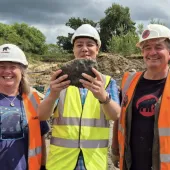Archaeological Finds From Waverley Wood

by Dr Jenni Chambers, Birmingham Archaeology, The Institute of Archeology & Antiquity, University of Birmingham
Over the last two decades sand and gravel extraction by Smiths Concrete at Waverley Wood Farm Pit at Bubbenhall, near Coventry, has provided scientists with the opportunity to investigate Pleistocene sediments laid down over 500,000 years ago. These investigations have provided a unique insight into Ice Age environments and the earliest inhabitants of the West Midlands.
The aggregates extracted at Waverley Wood are primarily the fluvial sands and gravels of the Baginton Formation, laid down by the Bytham river on to underlying Mercia mudstone. These Baginton sands and gravels are capped by the Thrussington till, which was deposited during the Anglian glaciation approximately 450,000 years ago (fig. 1).
During large-scale commercial excavations in the 1980s quarry workers noticed large bones within organic channels on the surface of the Triassic Mercia mudstone floor of the pit, sparking a small salvage excavation to assess these deposits by Quaternary researchers. These investigations documented four channels at the base of the Baginton sands and gravels, which preserved a wide range of organic materials including the bones and teeth of an ancient species of straight-tusked elephant, ‘Palaeoloxodon Antiquus’, and a single quartzite flake, the only in-situ Palaeolithic artefact recovered from the site. These finds pre-date the Anglian glaciation and are considered to be in excess of 500,000 years old.
However, while in-situ archaeology may be scarce within the Baginton Formation, artefacts are much more commonly found on the ‘reject heap’ of the Waverley Wood gravel processing plant. Since excavation in the 1980s, continued monitoring of the reject heap has produced a growing assemblage of artefacts, including (to date) 79 quartzite flakes and chopper tools, a quartzite hand axe, and five hand axes of green andesitic ash. Such activities do not disrupt quarrying operations and are of great benefit to Pleistocene research.
The assemblage of artefacts from Waverley Wood is the largest known from the region and demonstrates the ability of our hominin ancestors (believed to be Homo Heidelbergensis, as found at Boxgrove, West Sussex) to adapt their technologies to changing resources over half a million years ago. Chalk-dominated regions of the country, such as East Anglia and the south-east of England, would have provided hominins with abundant flint for stone tool manufacture, and indeed in these regions many thousands of Palaeolithic stone tools, such as hand axes, have been recovered — often as a result of the deep holes created by commercial sand and gravel extraction. There are no such sources of flint within the West Midlands region; therefore hominins had to turn to different raw materials. The artefacts from Waverley Wood demonstrate their ability to produce effective tools from more difficult materials such as quartzite, and their ability to exploit unfamiliar materials such as andesitic ash — an ancient volcanic sediment with excellent flaking properties, as the finely made ovate hand axes illustrate (fig. 2).
The Waverley Wood assemblage has been built up over many years of research and has only been possible through the generous co-operation of Smiths Concrete. Ready access to the site has been granted and researchers are informed if ‘interesting looking’ sediments are uncovered during extraction. In recent months organic sediments have been sampled for pollen and beetle remains and a broken biface (two-sided stone tool) made of Lincolnshire Wold flint has been recovered (fig. 3); this a most unusual find for the region, with substantial implications for our interpretations of hominin mobility across the landscape at these times.
The Palaeolithic record of the Midlands may appear sparse in comparison with that of southern England. Sites such as Waverley Wood, however, demonstrate the potential for meaningful Pleistocene research outside of seemingly prime regions. These artefacts testify to the earliest known human inhabitants of the West Midlands and are of both national and international significance, documenting the northernmost margins of the hominin world.








